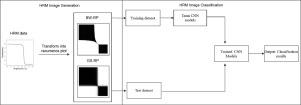Computer Methods and Programs in Biomedicine ( IF 4.9 ) Pub Date : 2021-05-05 , DOI: 10.1016/j.cmpb.2021.106139 Fatma Ozge Ozkok 1 , Mete Celik 1

|
Background and Objective: High resolution melting (HRM) analysis is a rapid and correct method for identification of species, such as, microorganism, bacteria, yeast, virus, etc. HRM data are produced using real-time polymerase chain reaction (PCR) and unique for each species. Analysis of the HRM data is important for several applications, such as, for detection of diseases (e.g., influenza, zika virus, SARS-Cov-2 and Covid-19 diseases) in health, for identification of spoiled foods in food industry, for analysis of crime scene evidence in forensic investigation, etc. However, the characteristics of the HRM data can change due to the experimental conditions or instrumental settings. In addition, it becomes laborious and time-consuming process as the number of samples increases. Because of these reasons, the analysis and classification of the HRM data become challenging for species which have similar characteristics.
Methods: To improve the classification accuracy of HRM data, we propose to use image (visual) representation of HRM data, which we call HRM images, that are generated using recurrence plots, and propose convolutional neural network (CNN) based models for classifying HRM images. In this study, two different types of recurrence plots are generated, which are black-white recurrence plots (BW-RP) and gray scale recurrence plots (GS-RP) and four different CNN models are proposed for classifying HRM data.
Results: The classification performance of the proposed methods are evaluated based on average classification accuracy and F1 score, specificity, recall, and precision values for each yeast species. When BW-RP representation of HRM data is used as input to the CNN models, the best classification accuracy of 95.2% is obtained. The classification accuracies of CNN models for melting curve and GS-RP data representations of HRM data are 90.13% and 86.13%, respectively. The classification accuracy of support vector machines (SVM) model that take melting curve representation of HRM data is 86.53%. Moreover, when BW-RP representation of HRM data is used as input to the CNN models, the F1 score, specificity, recall and precision values are the highest for almost all of species.
Conclusions: Experimental results show that using BW-RP representation of HRM data improved the classification accuracy of HRM data and CNN models that take these images as input outperformed CNN models that take melting curve and GS-RP representations of HRM data as inputs and SVM model that take melting curve representation of HRM data as input.
中文翻译:

高分辨率熔解分类递归图的卷积神经网络分析
背景与目的:高分辨率熔解 (HRM) 分析是一种快速、正确的物种鉴定方法,例如微生物、细菌、酵母、病毒等。HRM 数据是使用实时聚合酶链式反应 (PCR) 和每个物种都是独一无二的。HRM 数据的分析对于多种应用很重要,例如,用于检测健康疾病(例如,流感、寨卡病毒、SARS-Cov-2 和 Covid-19 疾病),用于识别食品工业中的变质食品,用于法医调查中的犯罪现场证据分析等。但是,HRM数据的特征可能会因实验条件或仪器设置而改变。此外,随着样本数量的增加,它变得费力和耗时。由于这些原因,
方法:为了提高 HRM 数据的分类精度,我们建议使用 HRM 数据的图像(视觉)表示,我们称之为 HRM 图像,使用递归图生成,并提出基于卷积神经网络 (CNN) 的 HRM 分类模型图片。在这项研究中,生成了两种不同类型的递归图,即黑白递归图(BW-RP)和灰度递归图(GS-RP),并提出了四种不同的 CNN 模型来对 HRM 数据进行分类。
结果:基于每个酵母物种的平均分类准确度和 F1 分数、特异性、召回率和精度值来评估所提出方法的分类性能。当 HRM 数据的 BW-RP 表示用作 CNN 模型的输入时,获得了 95.2% 的最佳分类精度。CNN模型对HRM数据的熔解曲线和GS-RP数据表示的分类准确率分别为90.13%和86.13%。采用 HRM 数据熔解曲线表示的支持向量机 (SVM) 模型的分类准确率为 86.53%。此外,当 HRM 数据的 BW-RP 表示用作 CNN 模型的输入时,几乎所有物种的 F1 分数、特异性、召回率和精度值都是最高的。
结论:实验结果表明,使用 HRM 数据的 BW-RP 表示提高了 HRM 数据和以这些图像作为输入的 CNN 模型的分类精度,优于以 HRM 数据的熔化曲线和 GS-RP 表示作为输入的 CNN 模型和 SVM 模型以 HRM 数据的熔解曲线表示作为输入。











































 京公网安备 11010802027423号
京公网安备 11010802027423号